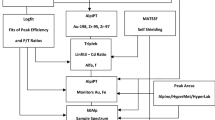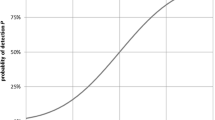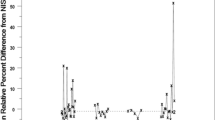Abstract
In this work, which is part of a larger effort to develop a software to automate instrumental neutron activation analysis calculations, the elemental concentration in a sample was calculated using either a set containing only the gamma-ray peaks recommended in the literature or a set containing all peaks identified. The results for each element were reduced using five tools: the usual unweighted and weighted means, plus the limitation of statistical weight, Normalized Residuals and Rajeval. The results were compared to the certified value for each element, allowing for discussion on the performance of each statistical tool and on the choices of peaks.
Similar content being viewed by others
References
Oliveira PMS, Munita CS, Hazenfratz R (2010) Comparative study between three methods of outlying detection on experimental results. J Radioanal Nucl Chem 283:433–437
Rajput MU, Ali N, Hussain S, Mujahid SA, MacMahon D (2012) Beta decay of the fission product 125Sb and a new complete evaluation of absolute gamma ray transition intensities. Rad Phys Chem 81:370–378
Bode P (1990) Practical aspects of operating a neutron activation analysis laboratory. Tech Rep IAEA-TECDOC-564, International Atomic Energy Agency
Blaauw M (1994) The holistic analysis of gamma-ray spectra in instrumental neutron activation analysis. Nucl Instrum Methods A 353:269–271
Rock NMS (1988) Summary statistics in geochemistry: a study of the performance of robust estimates. Math Geol 20:243–275
Lister B (1986) Best estimates from interlaboratory data. Anal Chim Acta 186:325–329
Chueinta W, Hopke PK, Paatero P (2000) Investigation of sources of atmospheric aerosol at urban and suburban residential areas in thailand by positive matrix factorization. Atmos Environ 34:3319–3329
Paatero P, Tapper U (1994) Positive matrix factorization: a non-negative factor model with optimal utilization of error estimates of data values. Environmetrics 5:111–126
Reimann C, Filzmoser P (2000) Normal and lognormal data distribution in geochemistry: death of a myth. Consequences for the statistical treatment of geochemical and environmental data. Environ Geol 39:1001–1014
Browne-Moreno E (2008) Joint ICTP-IAEA workshop on nuclear structure and decay data: Theory and evaluation—ENSDF decay (decay data). Technical report, International Atomic Energy Agency
Rajput MU, MacMahon TD (1992) Techniques for evaluating discrepant data. Nucl Instrum Methods A 312:289–295
Author information
Authors and Affiliations
Corresponding author
Rights and permissions
About this article
Cite this article
Zahn, G.S., Genezini, F.A., Secco, M. et al. Can robust statistics aid in the analysis of NAA results?. J Radioanal Nucl Chem 306, 607–610 (2015). https://doi.org/10.1007/s10967-015-4163-9
Received:
Published:
Issue Date:
DOI: https://doi.org/10.1007/s10967-015-4163-9




